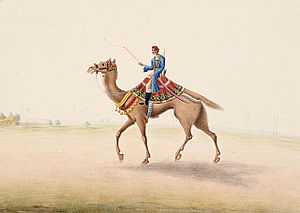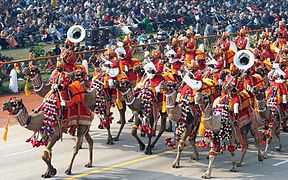Camel cavalry

Camel cavalry, or camelry, is a generic designation for armed forces using camels as a means of transportation. Sometimes warriors or soldiers of this type also fought from camel-back with spears, bows or rifles.
Camel cavalry were a common element in desert warfare throughout history due in part to the animal's high level of adaptability. They provided a mobile element better suited to work and survive in an arid and waterless environment than the horses of conventional cavalry. The smell of the camel according to folklore alarms and disorients horses, making camels an effective anti-cavalry weapon. For this purpose Emperor Claudius is said to have brought a detachment of camel cavalry as part of his invasion force for conquering Britain.
Early history

The first recorded use of the camel as a military animal is by the Arab king Gindibu, who is claimed to have employed as many as 1000 camels at the Battle of Qarqar in 853 BC. A later instance occurred in the Battle of Thymbra in 547 BC, fought between Cyrus the Great of Persia and Croesus of Lydia. According to Xenophon, Cyrus' cavalry were outnumbered by as much as six to one. Acting on information from one of his generals that the Lydian horses shied away from camels, Cyrus formed the camels from his baggage train into an ad hoc camel corps. Although not technically employed as cavalry, they were crucial in panicking the Lydian cavalry and turning the battle in Cyrus' favor.
Muslim conquests and colonial period

The camel was used in this way by many civilizations, especially in Arabia and North Africa. Both camel and rider were sometimes armored like the contemporary cataphracts. The Arabs used camels to great effect against their horse-mounted European enemies during the Muslim conquests. Napoleon used camels for his French campaign in Egypt and Syria.
During the late 19th and much of the 20th centuries, camel troops were used for desert policing and patrol work in the British, French, German, Spanish and Italian colonial armies. Descendants of such units still form part of the modern Indian, Moroccan and Egyptian armies. The British-officered Egyptian Camel Corps played a significant role in the 1898 Battle of Omdurman; one of the few occasions during this period when this class of mounted troops took part in substantive numbers in a set-piece battle.
Camels are still used by the Jordanian Desert Patrol.[1]

See also
- Bikaner Camel Corps
- Dromedarii
- Imperial Camel Corps
- Méhariste
- Somaliland Camel Corps
- Sudan Defence Force
- Tropas Nomadas
- U.S. Camel Corps
- Zaptié
- Zumbooruck
parody:
- Hawmps 1976 comedy movie about fictional camel unit in the Old West of the United States
References